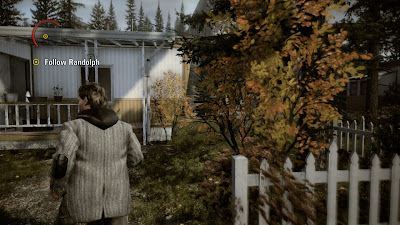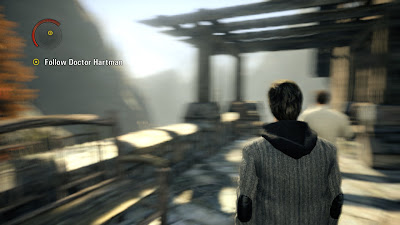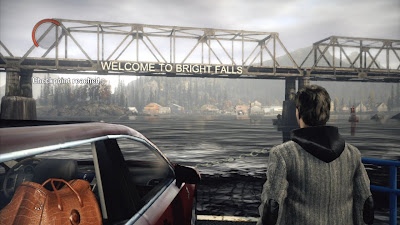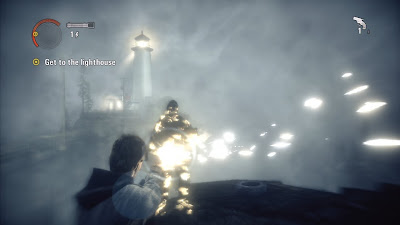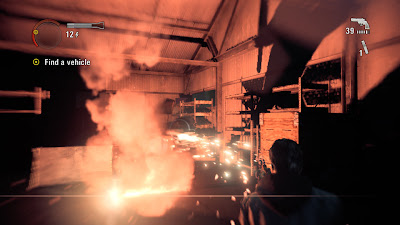The underlying engine behind the game is based on the same impressive tech that powered 2008’s GTA IV, expanded upon, tweaked and refined, perhaps pushing the most it can get out of the current consoles. Well, without a complete rewrite that is. And like with the GTA IV conversion, there are many similarities between the two games. Everything from the rendering resolution and the use of anti-aliasing can be plucked right out of Rockstar’s last multiplatform title, so it’s no surprise that some of what you’ll be hearing today is at least vaguely familiar.
Starting off, as always with the rendering resolution. RDR is presented in 720p (1280x720) on the Xbox 360 using 2xMSAA (multi-sampling anti-aliasing), whilst on PS3 is rendered in a slightly lesser 1152x640 and using the alternative QAA (quincunx anti-aliasing).
Straight away you can see that Red Dead is exactly the same as GTAIV in this regard, with the 360 benefiting from decent edge smoothing, and the PS3 having to make do with the blurrier quincunx solution. This choice appears a little odd, as both 2xMSAA and the standard QAA take up roughly the same amount of memory and processing requirements. So why use the poorer QAA option in the first place?


Well, the most obvious explanation is that the QAA in theory delivers more edge smoothing for the same memory cost as the conventional MSAA, so thus there should be less in the way of jagged edges. However the consequence is that QAA not only smoothens polygon edges, but also blurs general pixel details in the entire scene. So textures along with geometry become blurred, creating a softer overall image. Bizarrely the use of this QAA seems to be selective, with some edges getting clear levels of jaggies reduction, and others without.
Unlike in GTAIV, in which the blur effect actually added an ambience and a layer of atmosphere to the proceedings, in Red Dead it does nothing of the sort. The gritty environments of GTA made the QAA look fit in well with the game world, and the 360’s dithered textures made the loss of sharpness a worthy compromise on PS3. However RDR on 360 doesn’t really suffer from any dithering textures. Or rather, that the effect has been greatly reduced, and the bright and dusty open world nature of the game benefits from a sharper image, meaning that the blur effect simply heightens the differences between the two versions.
The 360 build however, isn’t free from criticism either. The high contrasting edges between the buildings with the bright blue sky often leads to noticeable shimmering, sometimes as bad as seen in the PS3 build. Most of the time these jaggies are in fact smoother than the ones seen on its PS3 counterpart but shimmer in the same way.
Essentially MSAA works by taking samples from two adjacent pixels, and then combines those samples with the final image to form an anti-aliased one. With edges in high contrast areas, there isn’t enough information to create decent samples to act as in betweens where the two pixels meet, thus the image receives either no AA altogether, or a significantly reduced amount.


In terms of texture detail and filtering, both versions are identical. Texture resolution seems to be the same on either platform with the lower 640p resolution of the PS3 game resulting in some additional blurring of the visible detail. This is caused by both the upscaled nature of the framebuffer, and the use of QAA, in which we’ve already discussed the technique’s unwanted side effects.
Anisotropic filtering is evident in the screenshots below, as is the blurred nature of the PS3 version’s textures, and general screen composition. The levels of AF don’t appear to be much higher than what is usually available with the older trilinear method of filtering. So we are looking at perhaps 4x AF for Red Read on both platforms.


One area of the game that has been noticeably paired back on the PS3, is the heavy use of alpha-based foliage. This seems to be the main reason for the lower resolution of the PS3 version and it’s use of a more aggressive LOD (level of detail) system in certain scenarios.
As we’ve discussed before at IQGamer, the use of alpha heavy transparency effects for objects like hair and foliage use up a huge amount of bandwidth, a commodity which is particularly limited in home consoles, but especially on the PS3 with its lack of high speed EDRAM. It’s this bandwidth advantage which allows the 360 to not only render more foliage on screen, but also render it at a higher resolution as well.
These two shots show exactly how much of the foliage has been cut back on the PS3 game. Notice how it is mostly only the smaller plants and grasses that have been culled, which actually has less of an impact during play than you might expect. However it’s also pretty clear that the environments in the 360 version look visibly more dense as a result of having loads more minor pieces of foliage.
Some major parts of the foliage have also been cut on PS3 too. When this happens, the Sony version of RDR looks much blander as a result, taking away some of that ‘living world’ look that the game at times possesses.


Whilst both versions use A2C (alpha-to-coverage) for the surrounding foliage - a memory saving technique for rendering half resolution transparencies in an interlaced type manner - the 360 version clearly benefits from better alpha blending through the use of A2C in conjunction with 2xMSAA.
On the other hand, the PS3’s use of QAA and low-resolution foliage makes for a poorer blend overall, and some unsightly shimmering artifacts which don’t look too great with the blurred nature of the framebuffer.
As regular readers of this blog might know, A2C also creates a screen door effect on all transparencies and textures that use it. MSAA is used to blend away this unwanted effect, and the more AA used, and the higher the resolution of the A2C textures, the better the overall result will be. For RDR the PS3 game and its use of low-res foliage and QAA simply makes the screen door effect stand out far more than it does on the 360. By contrast, it’s barely noticeable in motion in the 360 build.


Along with a reduced foliage count, the PS3 game appears to feature a more aggressive LOD system as well. It’s not so much the issue of objects being cut back on the PS3 build, but also of objects popping into view later than in the 360 one. Geometry changes, shadow pop, and object pop in are all more noticeable on the PS3. Although these do occur on 360, but to a far lesser extent.
Below you can see the differences between the two versions. Notice how the water effects and shadowing have been cut back on the PS3, with entire shadows missing altogether. Detail in the distance has been deduced, with buildings featuring simpler levels of geometry, and with some objects being completely omitted from the scene.
The PS3 version also suffers from some other LOD issues as well. In towns and small outposts, as you approach the buildings the shadows pop in a lot later in the PS3 build compared to the 360. They appear more erratically on the PS3, whereas on 360 they appear smoothly on screen from further into the distance, and in a far more succinct manner.
The reason why, on occasion, that so much detail has been reduced in the PS3 build, is due partially to the game’s lower resolution in combination with the blur inducing QAA, and what appears to be a more forceful LOD system.
Either way, the Sony game suffers far more from LOD issues and the overall more aggressive LOD system in place for RDR. Unlike in GTAIV, the whole game has been designed around sprawling vistas, and wondrous views into the far distance. So its no surprise that some large compromises had to be made for the PS3 build, especially where trying to keep a more consistant frame rate is concerned.


Red Dead Redemption aims to keep a steady 30 frames per-second framerate at all times, but both versions deal with doing this a little differently. Like with many multi-platform titles, the PS3 build is focused on eliminating screen tear at the expense of maximum smoothness, being v-synced that is, and the framerate also capped at 30fps maximum to ensure it never goes above this level.
The 360 build on the other hand is more concerned with maintaining as smoothest framerate as possible. And to that end the framerate hasn’t been capped at all, with the game running between 40 to 50fps in certain scenarios. This mainly happens when on foot, and in enclosed locations without much in the way of foliage and environment detail.
Most noticeably is the fact that the 360 game isn’t v-synced, or v-locked at all, meaning that it is prone to screen tearing in stressful situations or fast camera pans. The tearing only ever appears at the top of the screen, and stops halfway across the screen, almost like the game has caught up with the problem.
By contrast the PS3 game never tears any frames at all, remaining completely free of the problem regardless of what is happening on screen. However, it does drop framerate badly in heavy load situations, far more than the 360 game. When this happens, the screen can crawl with jagged edges and shimmering foliage in areas in which the QAA isn’t applied, and where the A2C blend fails to work successfully.
Both versions do massively drop their framerate in heavy load situations, but it’s the PS3 one that seems to be more greatly affected by such dips in performance.
So it is safe to say that performance wise the 360 version has the edge, and that the screen tearing present on that version of the game isn’t much of an issue, being barely noticeable for much of the time. By contrast, the PS3 build features a small drop in IQ over the already worse 640p resolution and use of QAA whenever the framerate drops. That said, neither version maintains the target 30fps for long, with constant dips below all throughout the game.


Moving on, we can see that in terms of lighting and shading there are differences in both versions of the game. For the most part they are both largely identical, but in certain circumstances the PS3 build actually features more light reflections and extra shadows cast in indoor areas, and the 360 build gets self-shadowing on all characters, which are absent for some on PS3.
The lighting differences don’t always seem to be technical achievements, but rather technical anomalies, in which it seems more likely that there is a rendering error on the 360 build compared to the PS3 one. Although we cannot be sure as to why this is happening without knowing the ins and outs of how Rockstar’s engine renders its shadows and lighting in detail.
In the screenshots below you can see how the PS3 version is casting a light source from outside and through the window, into the scene indoors. Whereas on 360 it is clear that the only light source affecting the characters is the one coming from the wall-mounted lamp.
The light source that is cast through the doors and windows on the PS3 game also casts shadows from the characters and onto the grown. Something that is also absent from the 360 build, which again only gets shadows from indoor lighting.
Thankfully these scenes are few and far in between as most of the game is set outside, in which there are only a few minor cloud shadow oddities in the 360 build. However it does mean that in indoor scenes the PS3 clearly demonstrates better use of lighting, whether that be due to an error or otherwise.


The 360 build however, does have the benefit of having both sharper and higher quality shadows for character and environmental objects. All characters on 360 have the benefits of using self-shadowing – shadows that are cast upon characters by themselves - which gives them an extra depth and three-dimensional look.
On PS3 characters generally look flatter than their 360 counterparts, with some lacking self-shadowing altogether, and others simply having the effect paired back over the 360 build.
It’s pretty obvious in the screenshots below how superior the shadowing can be in the 360 game. Notice how much extra in the way of depth the self-shadows can add over environment shadowing and lighting.


In the end, despite the differences we can still see that what Rockstar’s engine has achieved on both platforms is pretty impressive, with it’s ability to render miles of detailed scenery and still keep up a decent framerate outside of strenuous encounters. Red Dead Redemption may not be artistically pleasing to everyone, but is still a mean technical achievement. It is however, one which favours the strengths of Microsoft’s console, with the 360’s superior vertex processing capabilities and greater memory bandwidth.
From what we’ve uncovered today, it’s pretty clear that the 360 demonstrates superior technical prowess when it comes to handling the wide and open-world nature of Red Dead Redemption. Unlike in GTAIV, a far-reaching field of view is absolutely required in order for a game like RDR to accurately represent the time and period in which it’s set. And it’s also exactly the type of engine that is ill suited to PS3’s lack of bandwidth and vertex shader power.
It comes as no surprise then, to see that without large buildings and natural structures hiding far off areas, that Rockstar had little option but to noticeably cut back on the sheer amount of geometry present in the PS3 game. After all, you can’t start culling much in the way of unseen polygons when the game requires most of this detail to visible from far into the distance. Instead the only thing left to do is cut away at the foliage, sap away some of the resolution and try to make the best of what you’ve got left.
However most of these differences aren’t all that visible unless you’ve seen one version, and then moved on to playing the other. Someone whose only ever seen the PS3 game is more than likely not to notice most of the issues we’ve highlighted in our tech analysis, and will still enjoy the many superb experiences Red Dead has to offer. Perhaps the only thing that IS noticeable is the blurred nature of the game owning to the use of QAA. In that respect it is the game’s largest issue, and the one which takes away the most from the experience.
In conclusion, our recommendation rests with the 360 version. There’s simply no doubt that it’s use of a higher resolution, proper MSAA, better LOD detail, better shadowing system, plus more stable overall performance makes it the better of the two. This isn’t a case of GTAIV, in which the slightly blurred look adds to the visual style of the game world, but rather that every part of RDR benefits from having a generally cleaner and clearer look about it, with more detail and a smoother framerate all gelling it together.
However, that said there’s no reason for people with access to only a PS3 not to pick up Rockstar’s latest. As we’ve stated above, that unless you’ve seen the two versions running you’ll unlikely to notice most of the differences, and the game itself is the same on both platforms, being an utterly absorbing experience at times, and one of the best open world games to date.
Thanks to MazingerDUDE for the majority of our comparison screenshots, and as always, to Quaz51 for his exemplary pixel counting skills.





























